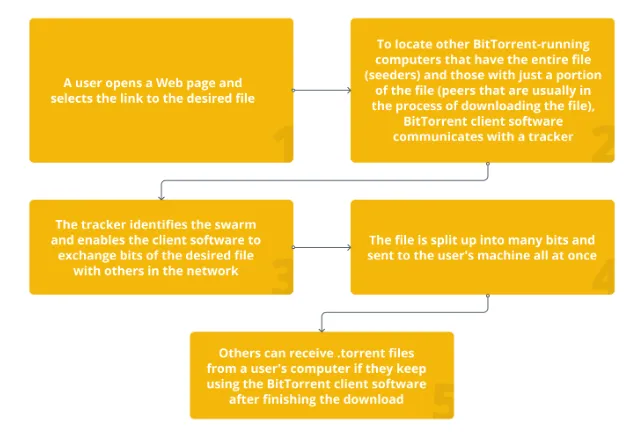- 1 BitTorrent is a distributed transfer protocol that is different from other internet transfer protocols.
- 2 With the increase in internet speed in 2008, BitTorrent faced an operational challenge, and TRON acquired it in 2019.
- 3 BitTorrent enables users to share files or content, including music and movies, among themselves without the involvement of intermediaries.
BitTorrent (BIT) is a peer-to-peer (P2P) file-sharing system on the torrent platform. It has implemented decentralization in the last few years.
BitTorrent is currently the largest decentralized P2P communications protocol in the world, as claimed in the whitepaper. This platform was originally established in July 2001, but later in 2018, blockchain platform TRON purchased it. Bran Cohen is the mastermind behind the development of BTT. He is a developer and an entrepreneur himself.
The main objective of BitTorrent was to develop the entertainment industry. It made obtaining entertainment material slow and expensive, as no content is available from free sources and rather works on a subscription model.
After the acquisition, TRON has added various tools to BitTorrent with a dedicated native cryptocurrency token, BTT. The BTT coin was launched in February 2019 on TRON’s own blockchain, utilizing its TRC-10 standard.
Process of Acquisition
The BitTorrent platform has been a part of various legal battles under Cohen’s control. Cohen maintained that it did not break copyright laws by allowing users to share files such as music and movies among themselves.
With the acquisition, control is transferred to Justin Sun. Sun made efforts for his plugging of both TRON as a cryptocurrency and its blockchain technology. For this, he bid $4.5 million at a charity auction to have lunch with Warren Buffet to discuss his viewpoints on cryptocurrency with him.
After the completion of the acquisition, TRON worked on the addition of cryptocurrency to BitTorrent, as the BTT token was also released on the TRON blockchain. They also made additional efforts to add and improve decentralized features to the platform.
Working of BitTorrent
In a P2P network, peers transfer the required files rather than servers. In contrast with the conventional client-server model of content delivery. However, it is not sure that online users will have the same software application on their computers to offer the content that others want to download.
Some users abandon the P2P network after their download is complete to prevent other users from downloading files from their machines. These users are known as leechers.
The BitTorrent protocol uses peers, seeds, a central tracker, swarms, and tit-for-tat rank to prevent leeching issues. Seeds are the files that have finished downloading in the user’s system.
Seeders are the users who download seeds to share with other users. To start the download of the preferred content, at least one seed needs to be on the BitTorrent network.
BitTorrent requires peers to organize themselves in an overlay network for each file being distributed. This network is known as a torrent with links among other peers. According to the protocol, users need to create a unique torrent for each distributed file.
Some file-tracking tasks are transferred to a tracker or central server. It serves as a meeting place for all torrent clients. However, it does not participate in the actual distribution of the file. Rather, it stores metadata about the active peers.
The client tries to maintain connections with 20-40 peers, while the tracker offers 50 peers selected at random among active peers. Anytime a client falls below 20 connections, it contacts the tracker to find more peers from the peer set.
Swarms are groups of BTT users, including peers, seeders, and leechers, connected by a tracker. It takes part in a torrent’s price exchanges. The file is divided into chunks of identical size, and clients in a peer set exchange these chunks with each other.
The process of sharing and receiving files on the BitTorrent network is called torrenting. BTT uses a tit-for-tat principle, according to which a central tracker is required to download a file from the BitTorrent network to share a part of their files.
When a user tries to obtain content from other users on the same network, BTT transfers file contents to the main tracker. The main tracker receives the content from the user and then uses it to serve other BitTorrent users.

The above picture shows the file transfer process in the BitTorrent Protocol.
Features of BitTorrent
BitTorrent is an efficient and cost-free file-sharing system in the users’ view. There are three versions of torrent downloaders, including BitTorrent Web for Windows and Mac users, BitTorrent Classic for Windows users, and BitTorrent Remote for Android users.
Other unique characteristics of BitTorrent are:
BitTorrent Speed
Initially, a torrent downloader was not rewarded for seeding content for a larger number of downloaders after a download was finished. So, BitTorrent launched BTT Speed to incentivize seeders with BTT tokens for seeding torrents.
BitTorrent Speed users can pay the BTT coin to accelerate their download speed. It also allows users to create a BTT Speed Wallet to store BTT and other cryptocurrencies. It also enables torrent clients such as BitTorrent Web, Torrent Classic (a desktop client), and Torrent Web.
DLive Protocol
It is a decentralized live-streaming platform that connects content producers with their audiences. Apart from low-cost streaming, users can also earn BTT tokens by watching the streams, which can then be staked to earn more tokens. During the live stream, streamers can also earn suggestions from their viewers.
Users do not need to use passwords or accounts to start streaming. They just need to set up their client. Data warehouses or servers are also not required to connect to the network.
BitTorrent File System (BTFS)
It is a decentralized file storage system where hosts offer storage to earn BTT rewards and renters consume that storage by paying BTT. Using the BTFS Gateway, any user can access the existing files on the BTFS network.
Conclusion: How Users can earn a BTT token
Users of the BitToken protocol can earn tokens in many ways, including torrenting and streaming content and staking their tokens. For example, the BitTorrent client can automatically earn BTT through seeding when a torrent file finishes downloading. Hosts in the BitTorrent File System can earn BTT rewards by offering storage to renters.
DLive Protocol’s streamers can earn BTT tokens by watching the streams. In addition, users can stake BTT with validators to earn passive income. Platforms like Binance offer BTT staking services.
FAQs
Where can a user buy BitTorrent?
BTT tokens can be traded on centralized crypto exchanges. The most popular exchange is DigiFinex. Other exchanges include Gate.io and OKX.
Which is the most active trading pair?
The most active trading pair on the exchanges is BTT/USDT.
What is the market sentiment for BitTorrent currently?
The community is quite bullish, as more than 95% of users are positive about the growth of BitTorrent.
Joseph Alalade is an expert Web3, crypto, and blockchain content writer and journalist. His persevering dedication to learning and understanding these complex subjects has equipped him with the ability to simplify them for any audience. Joseph’s expertise and passion for the industry make him a valuable asset for organizations seeking informative and engaging crypto-related content that drives results.


 Home
Home News
News










